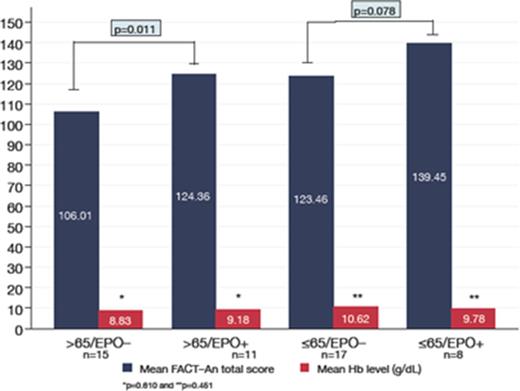Abstract
Myelodysplastic syndrome (MDS) is mainly a disease of elderly population. Chronic cytopenias, especially anemia, frailty comorbidities, and age may alter the physical status significantly. Only a few proportions of patients can achieve long-term cure. In particular, but not limited to patients with low risk MDS; palliative/supportive care is the mainstay of the treatment. Erythropoietin-stimulating agents (ESAs) and red blood cell transfusions are the treatment options for patients suffering from anemia. Except one study, ESA-responders had a better quality of life (QoL) in three studies. Hematologic improvements should be assesses by patient-reported outcomes (PROs) as well as objective measures. Validated PROs those were used to assess QOL in patients with MDS included Functional Assessment of Cancer Therapy- Anemia (FACT-An) and European Organization for Research and Treatment of Cancer QLQ-C30 (EORTC-QLQ C30) questionnaires and a MDS-specific questionnaire, QoL-E.
All patients with MDS were screened. Patients with low-risk MDS were included in the study. One physician completed FACT-An, Hematopoietic Stem Cell Transplantation-Comorbidity Index (HCT-CI), and G8 frailty questionnaires in all patients. Demographic data were collected from patients' chart records.
A total of 66 patients were screened. Fourteen patients were excluded due to high-risk MDS or indefinite diagnosis. In one patient, informed consent could not be obtained. Finally, 51 patients were included in the study. Median age was 66 years old (interquartile range [IQR]: 55-77). Twenty-one out of 51 patients (41.2%) were male. Most prevalent MDS subtype was MDS-refractory anemia (47%). All patients had very-low/low (86.3%) or intermediate-risk (13.7%) MDS according to age-adjusted IPSS-R (IPSS-RA). Median time from the diagnosis of MDS was 113 (IQR: 53-170) weeks. Twenty-eight patients (54.9%) were transfusion-dependent. Ten patients had a high transfusion burden, which was defined as transfusion requirement ≥4 units (U) over 8 weeks. Median transfusion duration was 112 (IQR: 31-173) weeks for transfusion-dependent patients. Median red blood cell transfusion during eight weeks was 1.5 (IQR: 0-4.5) U. Median hemoglobin concentration was 10.0 (7.9-11.3) g/dL for all patients. A total of nineteen patients (37.3%) were ESA-user/responder. Most of the patients (80.4%) had a low (<11 years) education level. Thirty-eight (74.5%) patients were living with their parents or partners. A half of the patients had an ECOG performance status ≤2. Sixty per cent were frail and 39% had significant (≥2) comorbidities.
In univariate analyses, older age (β: -0.740, 95% CI: -1.138; -0.341, p<0.001), higher transfusion burden (β: -7.235, 95% CI: -14.279; -0.190, p=0.044), intermediate risk IPSS-RA (β: -8.113, 95% CI: -15.715; -0.511, p=0.037), lower educational status (β: -19.625, 95% CI: -32.565; -6.684, p=0.004), lower ECOG performance status (≥2) (β: -14.385, 95% CI: -24.805; -3.964, p=0.008), frailty (β: -13.740, 95% CI: -24.518; -2.962, p=0.014), and being ESA-user/responder (β: -15.431, 95% CI: -26.141; -4.722, p=0.006) were associated with worse FACT-An total scores.
Multivariate analyses revealed that age (β: -0.738, %95 GA: -1.101; -0.374, p<0.001) and being ESA-user/responder (β: 15.368, %95 GA: 6.040; 24.697, p=0.002) were the only independent predictors of QoL in patients with low-risk MDS (Table 1, figure 1).
Model stability was tested in 5000 bootstrap replicates of dataset. Age and being ESA-user/responder were included in 40.6% and 38.2% of all models (Table 1).
These data indicates that age and ESA use are independent parameters of QoL in low-risk MDS. Impact of ESA use on QoL is independent from the hemoglobin level.
No relevant conflicts of interest to declare.
Author notes
Asterisk with author names denotes non-ASH members.



This feature is available to Subscribers Only
Sign In or Create an Account Close Modal